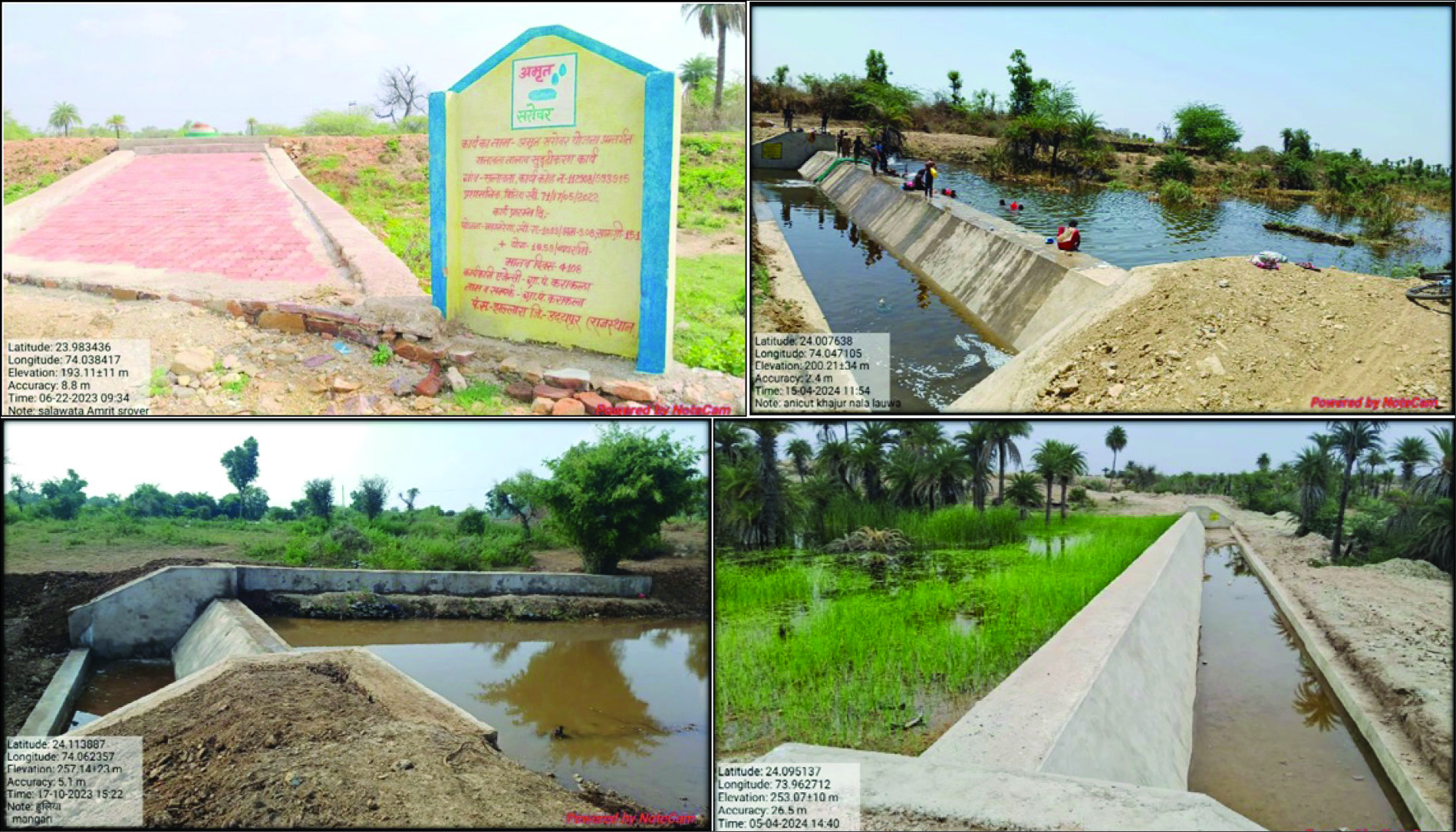Replenishing the parched land
A well-coordinated ‘Catch the Rain’ campaign in Rajasthan’s Salumbar district, led by District Collector Jasmeet Singh Sandhu, has led to sustainable water-harvesting initiatives in the region

In a state like Rajasthan, where water scarcity is a perennial issue, initiatives under the ‘Catch the Rain’ campaign and Jal Sanchay were launched to ensure water sufficiency in the district. The goal was to harvest every drop of rainwater and minimise water loss from various causes. As part of this, Salumbar district embarked on a massive exercise to construct water-harvesting structures such as anicuts, mini percolation tanks (MPTs), staggered trenches, ditches, contour trenches, and reservoirs like ‘amrit sarovars’ and ‘talabs’. During 2022-23, a total of 1,531 water harvesting and conservation projects were sanctioned. Timely project sanctions were secured under MGNREGA, the Pradhan Mantri Krishi Sinchayee Yojana (PMKSY), Atal Bhujal Yojana, the Integrated Watershed Management Programme, and the Jal Shakti Abhiyan. These projects are at various stages of completion, resulting in a significant improvement in surface water availability. Additionally, surplus water is being directed to Jaisamand Lake, which has a holding capacity of 14,650 mcft at its full reservoir level of 295.5 m. Jaisamand Lake, Asia's second-largest artificial lake, thus serves as a valuable reservoir for the district. These water-harvesting sites ensure ample water for both humans and animals and are also being utilised as source water for the Jal Jeevan Mission to ensure long-term source sustainability.
Water harvesting sites were constructed in the district after involving all the stake-holders. In each of these programmes, a shelf of works was prepared. All these works were put up before Gram Sabha, and after its approval, they were finalised. Other stakeholders were also consulted. The Water Resources Department was consulted to guide on technical aspects of the programme as were the NGOs working in the field of ‘jal’. Elected representatives were involved in site selection and using local methodology to solve water issues. As part of this programme, all tubewells and hand pumps were provided with soak pits in order to ensure water recharge and minimal water loss. Jal shapaths were administered to people to make them aware of water conservation as well as the need to ensure that every drop of water be used as judicially as possible. Rooftop water harvesting structures were made a norm for urban societies in order to use rainwater. Farmers were roped in via farm ponds to ensure every farmer harvests rainwater. Sheet-based farming is being practised in order to minimise water losses. Thus, all stakeholders have converged to ensure water availability.
One of the major issues was that people were unaware of the seriousness of the issue. There was, thus, misuse of water and wastage. Additionally, there was a lack of coordination among departments responsible for water harvesting and supply. Under the district administration's ‘Catch the Rain’ and Jal Sanchay initiatives, these departments—including the Watershed Department, RDPRD, Groundwater Department, Public Health Engineering Department, and Urban Development Department—were brought together. A large-scale communication campaign was launched to increase awareness of the judicial use of water, reinforced through the administration of ‘Jal Shapaths’. Water-harvesting sites were also integrated as source points for the Jal Jeevan Mission. Previously, water issues in villages were viewed narrowly, with a focus on constructing hand pumps and tube wells, often overlooking water-harvesting techniques. The community saw MGNREGA as a way to gain government benefits, without fully realising the potential of water conservation. By making the process participatory and transparent, these issues were addressed effectively.
The strategy was to make this initiative sustainable by finding local and pro-environment solutions. Consequently, efforts were made to ensure that these water-harvesting structures provide water for all surrounding flora and fauna. An attempt was also made to keep processes transparent. Work sites were selected following stakeholder consultations, and MGNREGA was integrated into these projects to ensure local work availability and accountability. The techniques of MPT, anicut, CT, and talabs used in the initiative are designed to make the model replicable in other parts of Rajasthan.
As mentioned earlier, the water-harvesting mission requires all stakeholders to be well-informed about effective water-harvesting methods. A large-scale campaign was launched for this purpose. In addition to newspapers, print and electronic media were used to raise awareness on water issues and strategies. Community radio services were also utilised, along with nukkad nataks and kathputli shows on the theme of water. Social media platforms like WhatsApp, Facebook, and Twitter were used to reach the community about water and water-harvesting practices, with all campaigns conducted in the local language.
The RDPRD served as the nodal department and hence panchayats were the most important stakeholders. Through collaborative exercises, panchayats and the common public were motivated around the concept of water and water harvesting. District officers were made in-charge of a few panchayats. They were made responsible for going to these panchayats and motivating people. NGOs were involved by asking them to mobilise the community. The best NGOs were encouraged and awarded at district level for their work. Self-help groups of women were key units involved in ensuring judicious utilisation of water resources. Apart from this, visits of experts in the area of water-management were also organised.
One of the major outcomes of the initiative has been that the district has turned water sufficient. Locally managed sources of water are available in nearly all villages. Another key outcome has been that it has ensured source sustainability under points of water supply for JJM. There have been positive health outcomes as well. It has led to empowerment of women as their self-help groups have been used to manage water supply.
What has been accomplished in Salumbar District of Rajasthan under the inspired leadership of its District Collector, Jasmeet Singh Sandhu, and his dedicated team is a wonderful example of Nexus of Good. The model can be replicated and scaled through public-private partnership.
Views expressed are personal



